
Quercus palustris, also called pin oak, swamp oak, or Spanish oak, is a tree in the red oak section of the genus Quercus. Pin oak is one of the most commonly used landscaping oaks in its native range due to its ease of transplant, relatively fast growth, and pollution tolerance.

The marsh wren is a small North American songbird of the wren family. It is sometimes called the long-billed marsh wren to distinguish it from the sedge wren, also known as the short-billed marsh wren.

The American water shrew or northern water shrew is a shrew found in the nearctic faunal region located throughout the mountain ranges of the northern United States and in Canada and Alaska. The organism resides in semi-aquatic habitats, and is known for being the smallest mammalian diver.

Oryzomys nelsoni is an extinct rodent of María Madre Island, Nayarit, Mexico. Within the genus Oryzomys of the family Cricetidae, it may have been most closely related to the mainland species O. albiventer. Since its first description in 1898, most authors have regarded it as a distinct species, but it has also been classified as a mere subspecies of the marsh rice rat (O. palustris).

Scheuchzeria palustris, is a flowering plant in the family Scheuchzeriaceae, in which there is only one species and Scheuchzeria is the only genus. In the APG II system it is placed in the order Alismatales of the monocots.
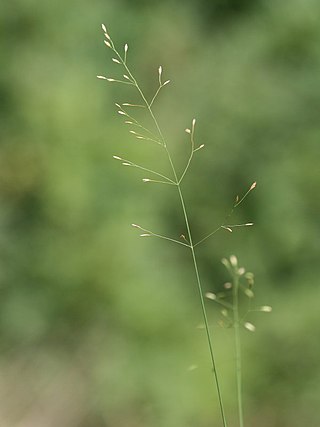
Poa palustris is a species of grass native to Asia, Europe and Northern America. This plant is used as fodder and forage, and it also used for erosion control or revegetation.

Oryzomys gorgasi, also known as Gorgas's oryzomys or Gorgas's rice rat, is a rodent in the genus Oryzomys of family Cricetidae. First recorded in 1967, it is known from only a few localities, including a freshwater swamp in the lowlands of northwestern Colombia and a mangrove islet in northwestern Venezuela. It reportedly formerly occurred on the island of Curaçao off northwestern Venezuela; this extinct population has been described as a separate species, Oryzomys curasoae, but does not differ morphologically from mainland populations.

The marsh rice rat is a semiaquatic North American rodent in the family Cricetidae. It usually occurs in wetland habitats, such as swamps and salt marshes. It is found mostly in the eastern and southern United States, from New Jersey and Kansas south to Florida and northeasternmost Tamaulipas, Mexico; its range previously extended further west and north, where it may have been a commensal in corn-cultivating communities. Weighing about 40 to 80 g, the marsh rice rat is a medium-sized rodent that resembles the common black and brown rat. The upperparts are generally gray-brown, but are reddish in many Florida populations. The feet show several specializations for life in the water. The skull is large and flattened, and is short at the front.

The marsh rabbit is a small cottontail rabbit found in marshes and swamps of coastal regions of the Eastern and Southern United States. It is a strong swimmer and found only near regions of water. It is similar in appearance to the eastern cottontail but is characterized by smaller ears, legs, and tail.
Palustris is a Latin word meaning "swampy" or "marshy", and may refer to:

Notiophilus is a genus of ground beetle native to the Palearctic, the Nearctic, the Near East and North Africa. Most known for their distinctive head shape and size-body ratio the genus is sometimes referred to as the springtail stalkers.

Notiophilus biguttatus is a species of ground beetle native to the Palearctic. It was first described by Johan Christian Fabricius in 1779. Sometimes referred to as the Common springtail stalker
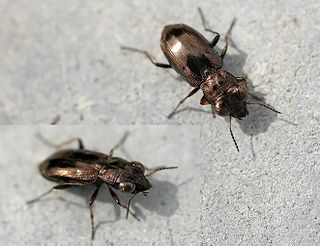
Notiophilus rufipes is a genus of ground beetle native to the Palearctic and the Near East.
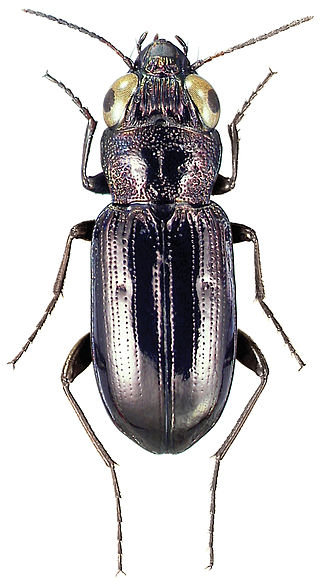
Notiophilus aquaticus is a species of ground beetle native to the Palearctic and the Nearctic. In Europe, it is found in Andorra, Austria, Belarus, Belgium, Bosnia and Herzegovina, Great Britain including the Isle of Man, Bulgaria, Croatia, the Czech Republic, mainland Denmark, Estonia, the Faroe Islands, Finland, mainland France, Germany, Iceland, the Republic of Ireland.

Hydroporus palustris is a species of ground beetle native to the Palearctic and the Near East. In Europe, it is found in Andorra, Austria, Belarus, Belgium, Bosnia and Herzegovina, Bulgaria, Corsica, Croatia, the Czech Republic, mainland Denmark, Estonia, the Faroe Islands, Finland, mainland France, Germany, mainland Greece, Hungary, mainland Italy, Ireland, Kaliningrad, Latvia, Liechtenstein, Lithuania, Luxembourg, North Macedonia, mainland Norway, Poland, Russia, Sardinia, Sicily, Slovakia, Slovenia, mainland Spain, Sweden, Switzerland, the Netherlands, Ukraine, the United Kingdom, and Yugoslavia.

Rorippa palustris, marsh yellow-cress, bog yellow-cress or common yellow-cress, is a species of flowering plant in the family Brassicaceae. It is widespread and native to parts of Africa, and much of Asia, Europe and Eurasia, North America and the Caribbean. It can also be found in other parts of the world as an introduced species and a common weed, for example, in Australia and South America. It is an adaptable plant which grows in many types of damp, wet, and aquatic habitat. It may be an annual, biennial, or perennial plant, and is variable in appearance as well.
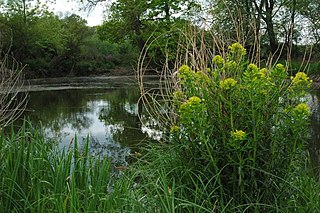
Euphorbia palustris, the marsh spurge or marsh euphorbia, is a species of flowering plant in the family Euphorbiaceae, native to marshland throughout much of mainland Europe and western Asia. It is an herbaceous perennial growing to 90 cm (35 in) tall and wide, with narrow leaves turning red and yellow in autumn, and persistent, bright acid yellow flower-heads (cyathia), 15 cm (6 in) across, in spring.
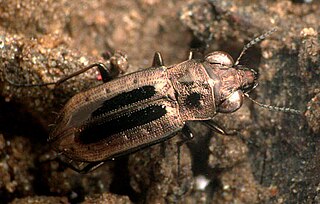
Notiophilus semiopacus is a species of ground beetle in the family Carabidae. It is found in Central America and North America.
Notiophilus borealis is a species of ground beetle in the family Carabidae. It is found in Europe and Northern Asia and North America.
Notiophilus aeneus, also known as the brassy big-eyed beetle, is a species of ground beetle in the family Carabidae. It is found in North America. Approximately 5–6 mm long, it is dark colored with a brassy tinge and large eyes. Adults are diurnally active in spring and summer.















